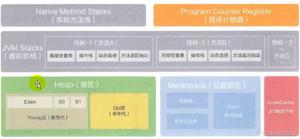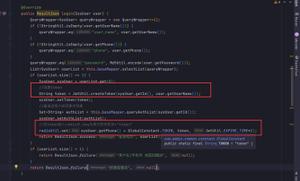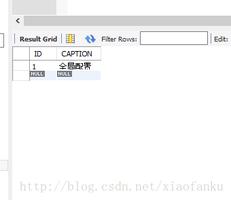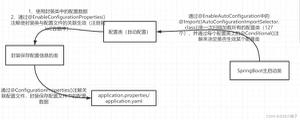Spring 中 Bean 的生命周期
本文内容纲要:
- **所谓 Bean 的生命周期,就是一个 Bean 从创建到销毁,所经历的各种方法调用。**大致包含下面几个方法(不是全部)
- Bean 的实例化,调用了构造方法。
- 使用 setter 方法填充属性。
- 一旦依赖注入完成,调用 Spring 感知接口 BeanNameAware.setBeanName()。
- BeanFactoryAware.setBeanFactory() 方法
- ApplicationContextAware 的 setApplicationContext() 方法
- BeanPostProcessor.postProcessBeforeInitialization 方法。
- @PostConstruct 标注的方法。
- InitializingBean.afterPropertiesSet() 方法
- 自定义的 init-method 方法
- BeanPostProcessor.postProcessAfterInitialization()
此时 Bean 可以用了。当容器关闭的时候,则会调用:
- @PreDestroy 标注的方法
- DisposableBean.destroy()
- 自定义的 destroy-method
- 对象自定义的 finalize 方法
其中,有几个方法是容器回调的方法,只要实现了感知接口,就会调用这些方法,比如 BeanNameAware.setBeanName(),BeanFactoryAware.setBeanFactory(),ApplicationContextAware.setApplicationContext()。了解感知接口,可参考 感知接口 。
生命周期之方法调用
- 后置处理器 BeanPostProcessor 接口
- @PostConstruct 和@PreDestroy
- InitializingBean.afterPropertiesSet() 和 DisposableBean.destroy()
- 自定义的 init-method 方法和 destroy-method 方法
这几组实现方式,都是在容器初始化对象和释放对象的时调用相关方法。它们之间并没有太大的不同,要说不同就是执行顺序的不同。BeanPostProcessor 的 postProcessBeforeInitialization,在初始化之前调用,接着@PostConstruct 标注的方法调用,然后 InitializingBean.afterPropertiesSet(),然后 init-method。通常使用时,根据个人喜好使用,个人比较喜好使用@PostConstruct 和@PreDestroy,因为简单。
BeanPostProcessor 接口
BeanPostProcessor 有一个不同于其他 3 个的点,实现 BeanPostProcessor 接口后,容器中的对象,在初始化前和初始化后,都会调用 postProcessBeforeInitialization 方法和 postProcessAfterInitialization 方法。即使这个对象并未实现 BeanPostProcessor 接口。而其他如@PostConstruct 注解等的实现方式中,仅作用在当前的 bean 上。因此 BeanPostProcessor 是全局性的,对容器中所有的对象都有效。
User类
@Componentpublic class User implements BeanPostProcessor { public Object postProcessBeforeInitialization(Object bean, String beanName) throws BeansException { System.out.println("postProcessBeforeInitialization..."+beanName+"=>"+bean); return bean; } public Object postProcessAfterInitialization(Object bean, String beanName) throws BeansException { System.out.println("postProcessAfterInitialization..."+beanName+"=>"+bean); return bean; } }
@Component
public class School {
}
Main方法
public static void main(String[] args) { // 使用Config.class这个配置类 AnnotationConfigApplicationContext applicationContext = new AnnotationConfigApplicationContext(Config.class); applicationContext.close(); }上述代码中,User 类实现了后置处理器接口,而 School 类并没实现该接口,但是 School 在初始化时,也调用了 User 类中的实现方法。Main 方法运行后的结果如下:
postProcessBeforeInitialization...org.springframework.context.event.internalEventListenerProcessor=>org.springframework.context.event.EventListenerMethodProcessor@25e20bbb postProcessAfterInitialization...org.springframework.context.event.internalEventListenerProcessor=>org.springframework.context.event.EventListenerMethodProcessor@25e20bbb postProcessBeforeInitialization...org.springframework.context.event.internalEventListenerFactory=>org.springframework.context.event.DefaultEventListenerFactory@3cbc6f29 postProcessAfterInitialization...org.springframework.context.event.internalEventListenerFactory=>org.springframework.context.event.DefaultEventListenerFactory@3cbc6f29 postProcessBeforeInitialization...config=>com.learn.Config$$EnhancerBySpringCGLIB$$5a156ddc@39960641 postProcessAfterInitialization...config=>com.learn.Config$$EnhancerBySpringCGLIB$$5a156ddc@39960641 postProcessBeforeInitialization...school=>com.learn.entity.School@c1c6d1b postProcessAfterInitialization...school=>com.learn.entity.School@c1c6d1bSpring 的底层,大量的使用到了后置处理器这个功能。
@PostConstruct 和@PreDestroy
@PostConstruct 和@PreDestroy 是 JSR-250(Java Specification Requests) 中定义的注解,Spring 也支持这些注解。@PostConstruct 和@PreDestroy 必须标注在无参数无返回值的方法上,当容器在加载 bean 时调用@PostConstruct 标注的方法,当容器释放 bean 对象的时候,调用@PreDestroy 标注的方法。
User类
@Componentpublic class User {
@PostConstruct
public void postConstruct1() { System.out.println("user postConstruct 1"); } @PreDestroy public void preDestroy() { System.out.println("user preDestroy 1"); } }
School
@Componentpublic class School {
@PostConstruct
public void postConstruct1 () { System.out.println("school postConstruct 1"); } @PreDestroy public void preDestroy1 () { System.out.println("school preDestroy1 1"); } }
Main方法
public static void main(String[] args) { // 使用Config.class这个配置类 AnnotationConfigApplicationContext applicationContext = new AnnotationConfigApplicationContext(Config.class); applicationContext.close(); }运行结果:
school postConstruct 1user postConstruct 1
user preDestroy 1
school preDestroy1 1
InitializingBean.afterPropertiesSet() 和 DisposableBean.destroy()
在 Spring 中,InitializingBean 和 DisposableBean 这两个接口中的方法,在对象的初始化和释放的时候,会被调用。
当 bean 中所有的属性都被赋值后,会调用 InitializingBean.afterPropertiesSet() 方法。
当 Spring 释放完 bean 后,会调用 DisposableBean.destroy() 方法。
User
@Componentpublic class User implements InitializingBean,DisposableBean { public void afterPropertiesSet() throws Exception { System.out.println("User Bean afterPropertiesSet called"); } public void destroy() throws Exception { System.out.println("User Bean destroy called"); } }
Main方法
public static void main(String[] args) { // 使用Config.class这个配置类 AnnotationConfigApplicationContext applicationContext = new AnnotationConfigApplicationContext(Config.class); applicationContext.close(); }运行结果
User Bean afterPropertiesSet calledUser Bean destroy called
init-method 方法和 destroy-method 方法
init-method 和 destroy-method 和上面两种方法一样,也是基于 Spring 容器加载对象和释放对象时,调用某些方法。其中指定的方法也需要是无参数,无返回值的。
User类
public class User { public void myinit() { System.out.println("myinit运行"); } public User() { System.out.println("User创建 "); } public void mydestroy() { System.out.println("mydestroy运行"); } }
@Configuration
@ComponentScan(value = "com.learn")
public class Config { @Bean(initMethod = "myinit", destroyMethod = "mydestroy") User getUser() { return new User(); } }
Main方法
public static void main(String[] args) { // 使用Config.class这个配置类 AnnotationConfigApplicationContext applicationContext = new AnnotationConfigApplicationContext(Config.class); applicationContext.close(); }运行结果
User创建 myinit运行
mydestroy运行
总结
Bean 的生命周期大致包括了这么多点,其实这么多点真正使用的并不多,并且使用场景都属于框架级别的,但是对于了解 Spring 容器的对象管理很有好处。
本文内容总结:,
原文链接:https://www.cnblogs.com/shoshana-kong/p/10692822.html
以上是 Spring 中 Bean 的生命周期 的全部内容, 来源链接: utcz.com/z/362461.html









